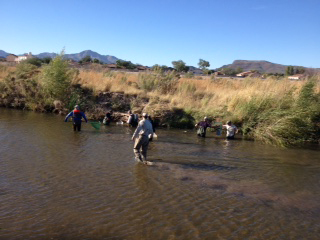 VIEW LARGER Scientists collect fish for the annual Santa Cruz River count.
VIEW LARGER Scientists collect fish for the annual Santa Cruz River count. On a blustery fall morning, a dozen people wade into the Santa Cruz River or stand on the riverbank, looking for fish.
They are just north of Cortaro Road, on Tucson's far northwest side.
They wear hip waders and carry buckets, nets and a device to deliver a mild electrical shock to the fish to catch them for a quick assessment before they are released.
The researchers are counting the numbers and kinds fish they find at each survey spot to compare with previous years. Four species, including one not seen previously in the river, are found at four locations.
“They are all non-native, but it’s really exciting to see that fish can survive in the river,” said Claire Zugmeyer, an ecologist with the Sonoran Institute, a partner in an ongoing study of the wetland conditions created and affected by effluent.
This is the fourth year scientists have searched for fish in the lower Santa Cruz. They are downstream of two new or updated wastewater treatment plants whose output provides the water in which the fish live.
The plants on Tucson’s northwest side began discharging clean water into the river three years ago, and the steady flow ranges from four inches to several feet, deeper at locations closer to the discharge points.
The river’s natural flow disappeared decades ago as groundwater was pumped for farming and municipal use. Now the treatment plants are helping give new life to a stretch of the Santa Cruz.
Finding fish in the river is just one indicator scientists use to evaluate the health of the waterway.
“Just the fish being there shows the river is much healthier than it used to be, not just for the fish but for the entire aquatic and riparian system,” said Doug Duncan, a biologist with the U.S. Fish and Wildlife Service.
Twenty-three miles of the Santa Cruz flows with treated wastewater and seasonal storm-water runoff. The year-round flow disappears into the riverbed south of the Pinal County line.
How is that stretch of the river hosting non-native species? Researchers speculate people catch the fish in ponds and lakes at nearby parks and put them in the Santa Cruz.
“The fish survey is something we’ve been doing every year for four years. We have seen the diversity of species increase over that time. Just today we found a lot of larger carp than we have in the past. And that’s a good sign of improved water quality,” said Brian Powell, a conservation biologist with Pima County.
The largest common carp among the 14 observed was about a foot long. The most numerous species was the mosquitofish, measuring barely two inches. The team counted more than 450 of them. The surveyors also spotted 25 black bullhead catfish, up from 3 last year. A new fish observed in the river was the bluegill sunfish - there were five of them caught.
The river hosts native species farther upstream, where a treatment plant near Nogales creates a continuous flow of treated water. Surveyors have found endangered Gila topminnow near Nogales and Tubac the past two years.
Zugmeyer said she hopes a big flood washes some of the topminnows downstream to Tucson one day. That would naturally re-establish a native species to this section of the river.
Duncan said knowing what species are in the river can help biologists decide what native fish could be introduced into the flowing waters if they don’t arrive in flood waters.
“One of the purposes we have of doing the survey is to see what’s here, ‘cause some of the non-native fishes are problems for our native fishes. They prey on them, they compete with them,” he said.
The surveyors are optimistic that fish populations will continue to increase, as long as there is water being introduced to the river.

By submitting your comments, you hereby give AZPM the right to post your comments and potentially use them in any other form of media operated by this institution.